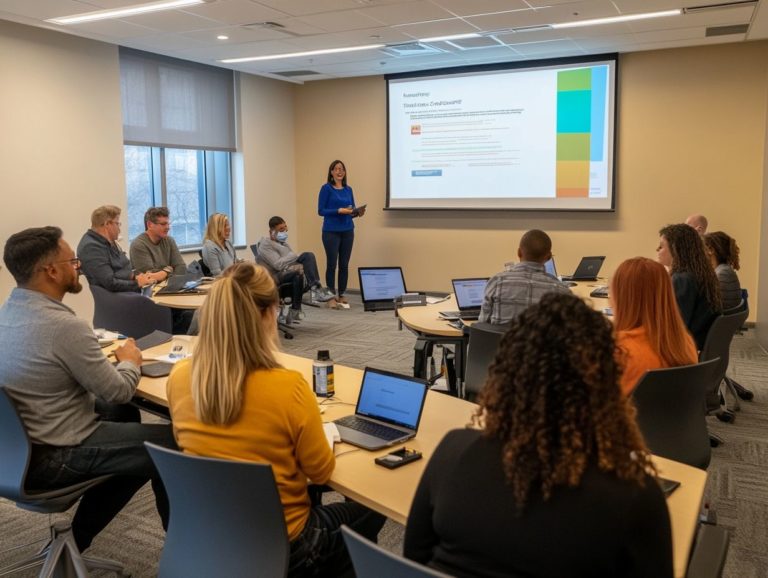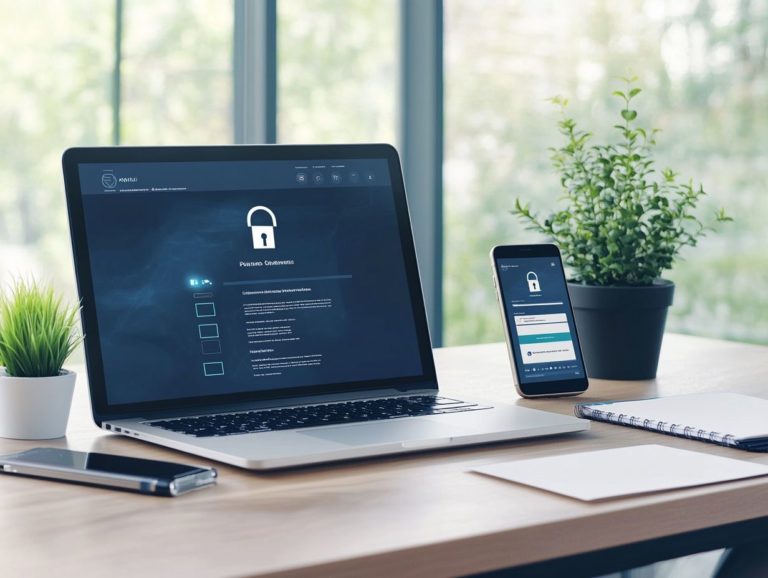10 tips for effective compliance management
In today’s intricate regulatory landscape, effective compliance management is crucial for any business aiming for success and sustainability. This article offers ten essential tips to guide you through the complexities of compliance, from grasping the regulatory framework to cultivating a culture of integrity among your employees. You ll discover the repercussions of non-compliance and how technology can bolster your compliance initiatives. Regardless of whether you’re an experienced professional or just stepping into the world of compliance, these insights will provide you with the essential tools to thrive.
Contents
- Key Takeaways:
- 1. Understand the Regulatory Landscape
- 2. Establish a Compliance Management System
- 3. Identify and Assess Risks
- 4. Develop Policies and Procedures
- 5. Train Employees on Compliance
- 6. Monitor and Audit Compliance
- 7. Respond to Compliance Issues Promptly
- 8. Keep Detailed Records
- 9. Stay Up-to-Date on Regulatory Changes
- 10. Foster a Culture of Compliance
- What Are the Consequences of Non-Compliance?
- How Can Technology Help with Compliance Management?
- What Are the Key Components of a Compliance Management System?
- How Can a Business Ensure Compliance Across Multiple Locations?
- What Are the Best Practices for Compliance Training?
- How Can a Business Measure the Effectiveness of Their Compliance Management?
- What Are the Common Challenges in Compliance Management?
- How Can a Business Prepare for a Regulatory Audit?
- What Are the Legal and Ethical Considerations in Compliance Management?
- How Can a Business Handle Whistleblowing and Internal Reporting?
- Frequently Asked Questions
Key Takeaways:

Understand the rules and regulations to effectively navigate compliance requirements and avoid consequences of non-compliance. Establish a compliance management system with policies, procedures, and training to identify and assess risks, monitor and audit compliance, and respond promptly to issues. To enhance your efforts, consider these 5 ways to ensure your compliance efforts are effective. Foster a culture of compliance, keep detailed records, stay up-to-date on regulatory changes, and utilize technology to ensure effective compliance management.
1. Understand the Regulatory Landscape
If you work in regulated industries like automotive or finance, knowing the rules is a game-changer for your success! Understanding the regulatory framework is essential because it helps you mitigate risks and ensure adherence to relevant laws and standards.
Take regulatory standards like ISO 26262, a standard that helps ensure vehicle safety, for example. They play a crucial role in the automotive sector by ensuring safety throughout the entire vehicle development lifecycle. The FDA regulations for medical devices are crucial for protecting public health, ensuring that products meet rigorous safety and effectiveness criteria.
By immersing yourself in these frameworks, you position your organization to identify compliance challenges early on, which can significantly shape your compliance strategies. This understanding not only aids in risk mitigation but also fosters innovation, creating a clear pathway for new products to achieve regulatory approval while meeting market demands.
2. Establish a Compliance Management System
Establishing a robust Compliance Management System (CMS) is essential for systematically managing compliance requirements. This allows for the effective implementation of compliance programs and frameworks that align with industry standards.
An effective CMS includes key components that work together to improve your overall compliance efficiency. Compliance tools are vital for ensuring that you can monitor and meet regulatory obligations seamlessly. Equally critical are documentation practices, providing a clear record of your compliance efforts and decisions.
Tracking mechanisms allow you to assess your adherence to these standards over time. When you integrate these elements, you optimize your compliance workflows and enhance visibility. This empowers your teams to identify potential gaps or areas for improvement, ultimately fostering a culture of accountability and continuous improvement.
3. Identify and Assess Risks
You must conduct a thorough risk assessment right away it s the key to navigating compliance successfully! This process enables you to pinpoint compliance risks and challenges that could obstruct your efforts to meet regulatory standards.
This assessment generally incorporates a range of methodologies, including interviews, surveys, and data analysis, all designed to reveal potential vulnerabilities within your operational practices. By evaluating risks through both qualitative and quantitative lenses, you can gain a clearer understanding of your compliance landscape.
Utilizing compliance metrics establishes a robust framework for assessing risk levels, allowing you to adopt a prioritized approach to your mitigation strategies. Metrics such as incident frequency, regulatory changes, and audit outcomes can provide valuable insights into the effectiveness of your existing controls.
This information gives you the power to make informed decisions about resource allocation and risk management initiatives, ensuring that your organization remains on a path of compliance excellence.
4. Develop Policies and Procedures
Developing comprehensive policies and procedures is essential for your compliance management strategy. They establish the framework to govern compliance activities and ensure adherence to guidelines.
These frameworks must be aligned with the latest regulatory standards, adapting as laws evolve to effectively minimize risks.
By establishing clear protocols and expectations, you empower your team to understand their responsibilities more thoroughly.
Well-documented procedures serve as invaluable resources during training sessions and audits. This cultivates a culture of accountability and ethical behavior.
When your entire organization is equipped with the right knowledge and tools, it enhances governance and strengthens overall performance in navigating the intricate compliance landscape.
5. Train Employees on Compliance
Training employees on compliance is essential for building a strong compliance culture within your organization. It ensures that every stakeholder clearly understands their roles and responsibilities in meeting compliance requirements.
Ongoing compliance training should be a dynamic process that evolves with changing regulations and industry standards. By employing methods such as interactive workshops, online e-learning modules, and real-time simulations, you can effectively engage your workforce.
This multifaceted approach empowers employees to recognize potential compliance issues before they escalate, fostering a proactive mindset.
A well-structured training program underscores the importance of meticulous compliance documentation, equipping your team with the skills they need to navigate complex regulatory landscapes with confidence.
6. Monitor and Audit Compliance
Regularly monitoring and auditing compliance activities is vital for your success! It ensures that your organization consistently meets its compliance objectives.
These processes help identify gaps in existing policies and facilitate the implementation of necessary corrective actions.
You would typically start compliance audits by establishing clear standards and guidelines, which serve as benchmarks for evaluation.
Compliance tracking tools are essential as they automate data collection and analysis, leading to more efficient audits. Technology enhances your monitoring capabilities, allowing you to detect potential compliance failures before they escalate.
By continuously tracking activities and outcomes, your monitoring efforts improve compliance strategies and ensure that regulations are met.
7. Respond to Compliance Issues Promptly

A prompt response to compliance issues is essential for minimizing the impact of any failures. It ensures that corrective actions are effectively implemented within your compliance procedures.
Having a well-structured response plan empowers you to swiftly identify potential risks, thoroughly investigate incidents, and efficiently resolve issues.
By establishing clear steps for investigation, your team can gather the necessary information and accurately assess the situation.
A comprehensive reporting process ensures transparency and accountability, keeping stakeholders informed about the actions taken.
Using compliance solutions enhances your workflow, allowing for timely identification and resolution of problems. These tools streamline communication across departments and help maintain essential documentation for follow-up reviews and audits, ensuring you remain compliant with regulations.
8. Keep Detailed Records
Maintaining detailed records is essential for effective compliance management. It provides a documented trail of compliance activities, metrics, and adherence to guidelines that can be invaluable during audits and assessments.
These records can include training logs, policy revisions, incident reports, and correspondence with regulatory bodies. Ensuring accuracy in these documents showcases your accountability and promotes transparency during examinations.
Having easy access to this information allows you to respond promptly to queries and fosters a culture of compliance within your organization. Effective record-keeping is crucial for tracking your compliance status and supporting timely reporting. Ultimately, this enables you to identify areas for improvement and mitigate potential risks before they escalate.
9. Stay Up-to-Date on Regulatory Changes
Staying current with regulatory changes is vital for ensuring your compliance programs remain effective and aligned with evolving requirements and challenges.
To achieve this, actively monitor regulatory developments by subscribing to industry alerts that deliver timely updates straight to your inbox. Engaging in compliance forums connects you with peers and industry experts, enhancing your understanding of emerging regulations.
This proactive approach improves your awareness and enables you to adapt your compliance strategies swiftly in response to regulatory shifts. By embracing these practices, you can significantly enhance your ability to navigate the complex compliance landscape with confidence and agility!
10. Foster a Culture of Compliance
Fostering a culture of compliance within your organization is crucial. Everyone, from leadership to operational staff, must embrace their role in upholding compliance and governance standards.
This requires a shared understanding of compliance objectives at every level, achieved through active participation and commitment from leadership.
As a leader, you must champion compliance practices, setting the tone that this is a top priority for your organization. Open communication is key; by encouraging discussions around compliance goals and expectations, you empower your employees to be more engaged and informed.
Regular compliance training sessions can reinforce the importance of adhering to regulations. A robust compliance culture safeguards against risks and nurtures a commitment to ethical practices that ultimately benefit the entire organization!
What Are the Consequences of Non-Compliance?
Non-compliance can lead to dire consequences! Organizations face financial penalties, legal troubles, reputational damage, and operational disruptions, making it imperative to prioritize compliance management.
Consider the infamous case of Enron. Their non-compliance fallout was devastating, leading to a bankruptcy that cost employees their jobs and investors their savings. The case prompted sweeping reforms in corporate governance. Similarly, companies like Volkswagen have faced hefty penalties and lasting reputational harm due to emissions scandals, underscoring the critical need for strict adherence to regulations.
By implementing proactive compliance management systems, you can significantly mitigate these risks. Fostering a culture where effective communication in compliance management is viewed as integral to your business success, rather than just a checkbox, is essential!
Investing in training, conducting regular audits, and maintaining open channels for communication enhances your resilience against potential breaches. Cultivate a workplace environment committed to ethical practices!
How Can Technology Help with Compliance Management?
Technology plays a crucial role in enhancing compliance management. It equips you with tools and solutions that streamline processes, improve tracking, and facilitate efficient audits.
Among the standout solutions are static code analysis tools, which automatically check your code for errors, and governance software. Together, these technologies empower your organization to achieve a higher level of compliance assurance. They let you monitor code quality and compliance in real time, ensuring that any potential issues are promptly identified.
Integrating data analytics within these tools provides valuable insights into trends and patterns. This enables your compliance team to proactively address risks.
Automated compliance documentation saves time and significantly reduces the chance of human error. This makes it easier for your organization to maintain accurate records and stay audit-ready.
What Are the Key Components of a Compliance Management System?
A comprehensive Compliance Management System (CMS) consists of essential components like effective compliance frameworks, well-documented procedures, and established metrics. These elements enhance compliance effectiveness and visibility.
These components work together seamlessly to create a strong structure for managing compliance risks and obligations. Compliance frameworks offer vital guidelines and best practices tailored to meet regulatory requirements. Well-documented procedures provide actionable steps for your teams, ensuring consistency and accountability.
Setting clear metrics is crucial for measuring performance and identifying areas for improvement. Regularly updating your compliance documentation and processes helps you stay aligned with evolving regulations. This allows your organization to adapt swiftly and effectively.
This proactive approach mitigates risks and fosters a culture of compliance, essential for maintaining trust and integrity in your organizational practices.
How Can a Business Ensure Compliance Across Multiple Locations?

Ensuring compliance across multiple locations means implementing standardized strategies that accommodate local regulations while fostering a cohesive compliance culture.
This task can be overwhelming given the diverse legal landscapes you may encounter. To manage compliance effectively, localized training programs are essential. These programs equip your employees with the knowledge they need to confidently navigate regional laws and your organizational policies.
Comprehensive documentation practices are crucial for aligning each location with both local and company-wide compliance objectives. Embrace compliance technology! It offers real-time oversight that can make a huge difference, allowing you to quickly identify potential risks across the board.
When combined, these approaches create a robust framework for maintaining compliance in varied operational environments, providing a solid foundation for your organization.
What Are the Best Practices for Compliance Training?
Strong compliance training makes a real difference! It helps you play your part in building a solid compliance culture within your organization.
To achieve this, consider using a mix of effective training methods:
- Interactive workshops create an environment that encourages collaboration and discussion among participants, allowing everyone to dive into real-world scenarios.
- E-learning modules offer flexibility to learn at your own pace, reinforcing key compliance concepts with engaging content that keeps you interested.
- Regular refreshers are equally important; they help keep compliance knowledge fresh and ensure it remains a priority in your daily work.
Measuring the effectiveness of these training initiatives through compliance metrics provides valuable insights. This guides future strategies and ensures you stay well-versed in your responsibilities.
How Can a Business Measure the Effectiveness of Their Compliance Management?
Measuring the effectiveness of compliance management is essential for assessing your organization’s performance and identifying areas for improvement through key compliance metrics.
Among the various metrics available, audit findings are a crucial benchmark, providing a clear view of how well your organization follows established policies and regulations.
Tracking incident response times reveals how quickly you react to compliance breaches. This is important for reducing risks and protecting sensitive data.
Employee training completion rates also provide insight into your workforce’s understanding of compliance protocols.
By continuously monitoring these metrics and adjusting your strategies, you can build a culture of accountability and ensure your organization stays aligned with changing regulatory standards.
What Are the Common Challenges in Compliance Management?
Organizations often face challenges in compliance management, such as staying updated on regulatory changes and effectively implementing compliance programs at all levels.
One significant hurdle is resource limitations, which can hinder effective compliance monitoring. For smaller organizations, limited budgets may restrict hiring a dedicated compliance officer or investing in advanced compliance software.
Training existing staff on compliance requirements can also feel overwhelming, especially in fast-changing industries like finance or healthcare.
To address these challenges, consider adopting centralized compliance management tools that provide automated updates on regulatory changes. This can relieve some of the pressure on your team.
Investing in modular training programs can ensure your employees receive relevant and timely compliance education without feeling overwhelmed.
How Can a Business Prepare for a Regulatory Audit?
Preparing for a regulatory audit is crucial for demonstrating compliance with applicable regulations and minimizing potential fallout from compliance failures.
Your first step should be a thorough review of your compliance documentation. Ensure that all relevant policies, procedures, and records are current and accurately reflect your organization s practices.
Conducting pre-audit assessments can help you identify any discrepancies or areas needing attention. This proactive approach allows you to address issues before they escalate.
Engaging stakeholders throughout the process fosters a culture of accountability and collaboration, further enhancing your preparedness.
These steps clarify expectations and lay a strong foundation. Remember, careful preparation is important for achieving successful audit outcomes and meeting your regulatory obligations.
What Are the Legal and Ethical Considerations in Compliance Management?
Legal and ethical considerations in compliance management are vital for building a robust governance framework that aligns with both regulatory requirements and ethical business practices.
It’s not just about meeting legal obligations; you should also foster a culture that emphasizes integrity and accountability.
The consequences of non-compliance can be severe, leading to hefty fines, reputational damage, and potential legal actions that can threaten your organization.
Building a strong compliance culture ensures that every employee understands their responsibilities, significantly reducing the risks of unethical behavior.
By integrating compliance into your core values, you can identify potential conflicts early and make informed decisions that honor both legal expectations and ethical standards.
How Can a Business Handle Whistleblowing and Internal Reporting?
Managing whistleblowing and internal reporting is vital for a culture of compliance. Employees must feel secure reporting incidents without fear of retaliation.
Establishing clear procedures enhances transparency and protects the identities of those who come forward. Anonymity is crucial in encouraging individuals to raise their concerns, as it alleviates their fears of negative consequences.
Implementing strong protection measures is essential to ensure whistleblowers are shielded from repercussions, fostering trust within your organization. Nurturing a supportive compliance culture empowers your team to quickly spot and tackle compliance issues, which ultimately leads to improved ethical standards and a stronger commitment to integrity.
Frequently Asked Questions

What Is Compliance Management?
Compliance management means making sure your business follows laws and regulations.
Why Is Effective Compliance Management Important?
Effective compliance management is important for businesses to avoid legal and financial consequences, maintain a good reputation, and promote ethical behavior within the organization. Following the 5 key steps to build a compliance program can help ensure these goals are met.
How Can I Improve My Compliance Management?
- Develop a compliance program
- Stay informed about relevant laws and regulations
- Communicate expectations clearly to employees
- Conduct regular risk assessments
- Provide training and resources
- Implement effective monitoring and reporting systems
- Encourage a culture of compliance
- Address compliance issues promptly
- Regularly review and update policies and procedures
- Seek expert guidance when needed
How Do I Develop a Compliance Program?
To develop a compliance program, start by identifying the relevant laws and regulations for your industry. Assess your current compliance practices, and establish policies and procedures to ensure compliance. It’s also important to assign a dedicated compliance officer and regularly review and update the program.
How Do I Encourage a Culture of Compliance in My Organization?
To encourage a culture of compliance, lead by example and prioritize compliance in all aspects of your organization. This includes regular training and communication, transparency in decision-making processes, and accountability for compliance violations.
Is There a Specific Compliance Management Framework I Should Follow?
While there are various compliance management frameworks, such as the COSO framework and ISO 19600, it’s important to choose one that aligns with your organization’s goals and objectives. It’s also recommended to seek expert guidance when implementing a compliance management framework.






